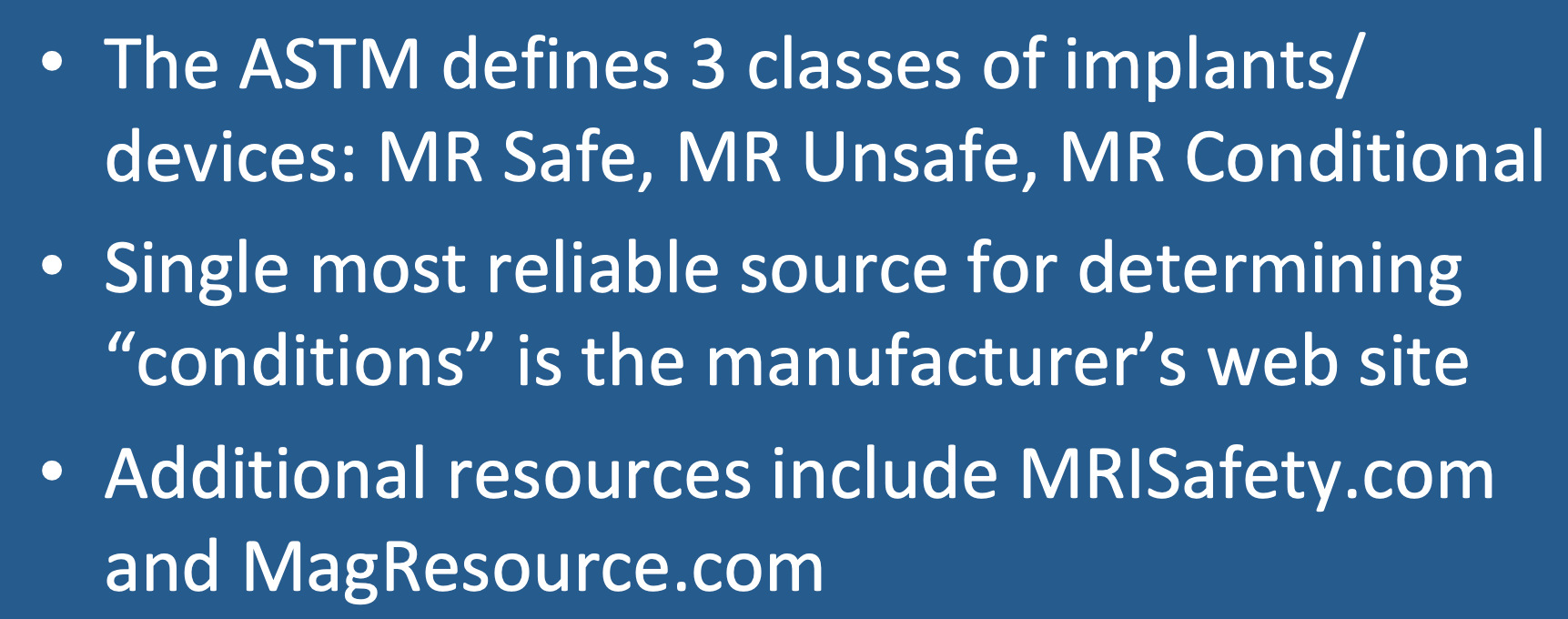|
MR SAFE
The device/implant is non- magnetic, non-conductive, and does not react to MR levels of radiofrequency irradiation. Its presence poses no risk to patients or staff in the MRI environment.
|
MR CONDITIONAL
The device/implant does contain magnetic, conductive or RF-reactive components, but is deemed safe for use in the MRI environment provided certain strict conditions are followed.
|
MR UNSAFE
The device/implant contains ferromagnetic materials or has such a response to electromagnetic irradiation that it poses potential harm to MRI patients or staff under all circumstances.
|
- MRISafety.com. Developed by my colleague, physiologist Frank Shellock, MRISafety.com provides a wealth of general and specific knowledge concerning MR safety with copious references. One of the sections is titled "The List", where over 5000 individual implants and devices are listed and categorized. Frank has further subdivided the ASTM's MR Conditional category into 8 Subtypes, which I personally don't use but may be helpful to some. Finally, like my own website, MRISafety.com is entirely free to use and does not require registration or log-on.
- MagResource.com. Developed by an MR technologist, Jan Gardner, MagResource.com is the most comprehensive site available, with information on over 20,000 items. There are direct links to nearly all device manufacturers, and they claim that if your implant isn't listed in their database they will research it and hunt it down for you. The site isn't free, but is quite a bargain -- only $240 for a single scanner for a year's subscription, with discounts for additional scanners. This is the site my MR staff usually goes to directly when an implant issue arises.
Advanced Discussion (show/hide)»
In 1997 the FDA Center for Devices and Radiological Health (CDRH) established two categories for MR device labeling: "MR Safe" and "MR Compatible". Considerable confusion arose between these two categories, so in 2005 they recommended adoption the three terms from ASTM F2503 ("Safe/Conditional/Unsafe"), requesting that manufacturers use them for all new products.
It should be noted that many devices and implants produced before 2005 still carry the old labeling. Moreover, the FDA only recommended (and did not require) manufacturers to use the new classification system. A relatively large number of devices in the current market have not been subjected to rigorous ASTM-style MR safety testing, or for that matter, any testing at all. Additionally, some manufacturers refuse to make any recommendations about whether or not their implants can be scanned safely. Others may simply declare their devices to be incompatible with MRI for legal purposes just because they contain a small amount of metal (when in reality, under proper testing some of these could easily qualify as "MR Conditional".
Finally, there are several recognized problems with the ASTM classification system. First, "MR Safe" devices cannot contain any metal what so ever. Thus the presence of even a trivial amount of metal, such as a tiny spring between two large plastic parts, immediately promotes the device into the "MR Conditional" category. Second, the "MR Conditional" category is extremely broad, ranging from devices with nearly zero risk at any field strength to ones that are close to the borderzone between Conditional and Unsafe. Finally, the term "MR Unsafe" is carries the false connotation that a person could be injured by being scanned with the device in place. In reality, a number of devices are labeled MR unsafe because the device itself may be damaged rather than direct injury to the patient occurring.
Al-Dayeh L, Rahman M, Venook R. Practical aspects of MR imaging safety test methods for MR conditional active implantable medical devices. Magn Reson Imaging Clinic N Am 2020: 28:559-571. [DOI Link]
ASTM F2503-20, Standard Practice for Marking Medical Devices and Other Items for Safety in the Magnetic Resonance Environment, ASTM International, West Conshohocken, PA, 2020, www.astm.org
ASTM F2182-19e2, Standard Test Method for Measurement of Radio Frequency Induced Heating On or Near Passive Implants During Magnetic Resonance Imaging, ASTM International, West Conshohocken, PA, 2019, www.astm.org
ASTM F2052-15, Standard Test Method for Measurement of Magnetically Induced Displacement Force on Medical Devices in the Magnetic Resonance Environment, ASTM International, West Conshohocken, PA, 2015, www.astm.org
ASTM F2213-17, Standard Test Method for Measurement of Magnetically Induced Torque on Medical Devices in the Magnetic Resonance Environment, ASTM International, West Conshohocken, PA, 2017, www.astm.org
ISO/TS 10974:2018. Assessment of the safety of magnetic resonance imaging for patients with an active implantable medical device (2nd Ed). International Standards Organization, Geneva, 2018.
Official Journal of the European Union, L 117, 5 May 2017. (most current regulations of implanted medical devices)
US Food and Drug Administration. Testing and labeling medical devices for safety in the magnetic resonance (MR) environment. Draft Guidance for Industry and Food and Drug Administration Staff. Final version 20 May 2021.
Shellock FG, Woods TO, Crues III JV. MR labeling information for implants and devices: explanation of terminology. Radiology 2009; 253:26-30. [DOI LINK]
What are the risks of passive vs active implants in MRI?
How do you calculate the magnetic force pulling a piece of metal toward the scanner?
What is SAR?




